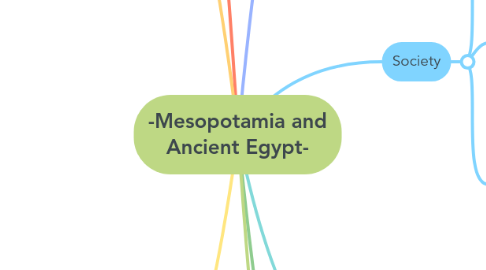-Mesopotamia and Ancient Egypt-
da Lucia Rodrigo Olmedo


1. Women in Ancient Egypt
1.1. Women depended on their fathers or husbands.Wohever, they had more feedom and rights than women in other societies during that period. They could control proprety and work.
2. Culture and religion in Ancient Egypt
2.1. The Egypcians made important changes in mathematics and astronomy to mesure time and predict the flooding of the Nile. They developed a solar calendar whit 12 months , each whit 30 days. They added 5 days, dedicated to the gods, to the final month to make a 365 -day year. They also invented the decimal system. We still use a similar system now a days.
2.2. Religion was Polytheistic. Egypcian gods often had human boday and head of an animal. Each city had its own patron deity and when a new capital emerged,its deity became more important. They had amulets for ask gods for help.
2.3. Egypcian society belived in life after dead. Therefore, people spent a lot of time and money on funeral rites. They belive that after someone died, the god Anubis accompanied the Ka into the afterlive.
3. Art and architecture in Ancient Egypt
3.1. Egypcians used stone, which is stronger than adobe. Therefore, many of these construcions still exist today, unike the Mesopotamian ones.
3.2. They build massive structures to reflect the power of their gods.
3.3. They used flat roofs supported on litels. Most Egypcian monuments were for religious and funerary purposes.
3.4. Tombs were buildings that contained burial chambers or rooms. This is where they placed sarcophagus whit the mummy. Some also had false empty chambers to confusse tomb robbers. There were three tipes of tombs.
3.5. Temples were buildings dedicated to the gods and only the priest could enter them. The Egypcians also acrved rock temples out of the mountains.
3.6. Mastabas were one-story rectangular buildings whit sloping walls.
3.7. Pyramids were called step pyramids when there was a division of levels. Later the Egypcians built classical pyramids whit smooth sides in Giza, such as the Pyramisd os Khufu, Khafre and Menkaure.
3.8. Hypogeums were hidden tombs cut out of the rockto prevent robbers from finding them. Most of them are in the Valley of the Kings.
3.9. Egypcians wanted to created art that was practical and durable.
4. Early urban civilisations
4.1. People lived near larges rivers to control flooding. The rivers deposit silt during the flooding making the riverbanks very fertile. As a result people obtained larges harvest.
4.2. Mesapotamia, the earliest fluvial civilisation, developed near the Tigris and Euphates rivers around 3200 B.C.
4.3. Egypt developed on the banks of the river Nile in 2850 B.C.
4.4. In india, the Harappa civilisation developed near the Indus River in 2500 B.C.
4.5. In China, a civilisation emerged near the Yellow River from the Xia dinasty and Shang dinasty.
5. Society
5.1. Privileged minority
5.1.1. Were the rich, powerful families. They lived in large houses or palaces and didn't need to work. The king in Mesopotamia and the pharaoh in Egypt held the most powerful position.
5.2. Unprivilaged majority
5.2.1. Worked for the privilaged minority and lived modestly in small houses. They were farmers, herders, fishermen and craftworkers.
5.3. Slaves
5.3.1. Were the propiety of other people and had no rights. They worked in domestic service , in mines and in the fields. Most slaves were prisioners of war or their descendants. Poor people that couldn't pay their debts also became slaves.
